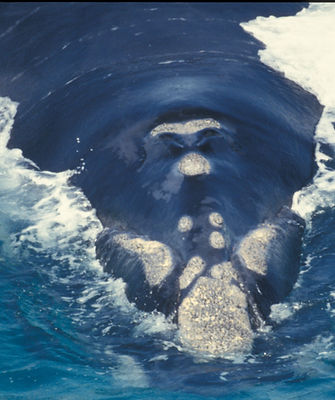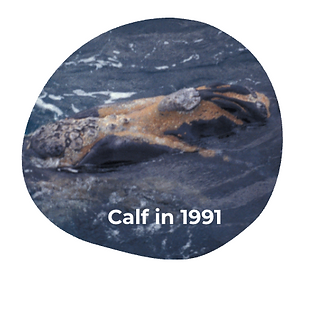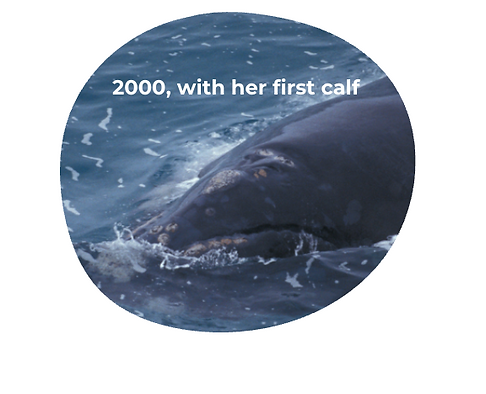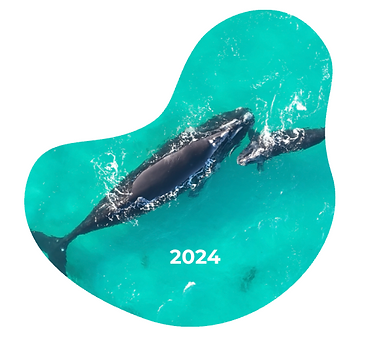
"The Southern Right Whale is an indicator species for climate change and the health of the southern ocean"
- Dr Claire Charlton
Who are these creatures?
The Southern Right Whale (Eubalaena australis) is a large, baleen whale species inhabiting the Southern Hemisphere. Adult individuals can reach lengths of up to 18 m and weigh as much as 80 tonnes. Females are typically larger than males. Notably, this species lacks a dorsal fin and has a broad back and large head, which bears rough patches of skin called callosities.

Where are the found in Australia?
In Australia, Southern Right Whales are found predominantly along the southern coastline. Key aggregation areas include Head of Bight and Fowlers Bay in South Australia. These areas serve as important calving and socialising habitats during winter and early spring.
Mating
Southern Right Whales display a non-monogamous mating system, with multiple males often competing to mate with a single female. Mating occurs at the surface in groups and may involve physical interactions among males.
Movement and Migration
Southern Right Whales undertake annual migrations between offshore feeding grounds (likely in sub-Antarctic waters) and nearshore breeding and calving areas. Within Australian waters, movements of 200–1,500 km between aggregation sites have been documented.
Photo-identification studies show strong interchange between Fowlers Bay and Head of Bight, with approximately 39% of individuals observed at both sites. Among females with calves, this figure rises to 59%, indicating regional connectivity.
Conservation Status
In Australia, the Southern Right Whale is listed as Endangered and Migratory under the Environment Protection and Biodiversity Conservation Act 1999 (EPBC Act). Continued research and monitoring are essential to inform conservation efforts and habitat protection strategies.
Reproduction and calving
On average, females will have thier first calf at 9 years of age. Following an 11–12 month gestation, calves are born measuring 4–5 m and weighing approximately 1–1.5 tonnes. Calves are nourished with energy-rich milk and may gain up to 100 kg per day in body mass.
Mothers typically remain with their calves in nearshore waters for several months, providing protection and nourishment. Calving occurs in three-year cycles on average, with many females returning to the same sites to give birth, indicating high site fidelity.
Population Status
Whaling in the 19th century led to severe population declines. Since international protection in 1935, some recovery has occurred.
Australia hosts two genetically and geographically distinct populations:
-
The south-western population (spanning Western Australia to South Australia) currently numbers around 2,500 individuals and is showing a steady increase (~7% per annum).
-
The south-eastern population (Victoria, Tasmania, New South Wales) remains under 300 individuals and is not showing significant recovery.
Acoustic Behaviour
Southern Right Whales produce a range of vocalisations that can be recorded using underwater acoustic recorders. These recordings provide insights into their spatial and temporal distribution, as well as behavioural ecology, including mother–calf communication and social interactions.
How we Identify Returning Whales
Researchers have been undertaking a comprehensive study of the whales at Head of Bight since 1991, photographing individuals, recording behaviour, mapping distribution, and gradually building up a picture of how the whales use the area. The unique markings (callosities) on the heads of the whales are used to identify individuals, enabling scientists to resight them in subsequent years or other places.
Blaze (Calving Female)

1991 cow with calf (Head of Bight)
1992 adult without calf (Head of Bight)
1993 not present
1994 cow with calf (Head of Bight)
1995-96 not present
1997 cow with calf (Head of Bight)
1998-99 not present 2000 cow with calf (Head of Bight)
2001 not present
2002 cow with calf (Head of Bight)
2003-04 not present
2005 cow with calf (Head of Bight)
2015 cow with calf (Head of Bight)
Blaze's Callosity Pattern
Chip (Adult Male)

1991 adult (Coorong, SA)
1992 not present
1993 adult (Head of Bight) 1
994 adult (Head of Bight)
1995-97 not present
1998 adult (Head of Bight)
1999-02 not present
2003 adult (Head of Bight)
2004-2014 not present
2015 Adult (Head of Bight)
Chips Callosity Pattern
Michelin Man (Male Born at HOB)

1991 calf (born at Head of Bight)
1992 1 year old (Head of Bight)
1993 2 year old (Head of Bight)
1994 3 year old (Head of Bight)
1995 4 year old (Yokinup Bay, WA) 1996 5 year old (Pt Ann, WA)
1997 6 year old (Head of Bight)
1998 7 year old (Dillon Bay, WA)
1999 not present
2000 9 year old (Head of Bight)
2001-2024 not present
Michelin Man's Callosity Pattern



Follow the Journey of a returning female at HOB as she grows alongside conservation







1991 - The first researchers conduct surveys at Head of Bight
2000 - EPBC act labels Southern Right Whales as Endangered
2005 - First National recovery plan for Southern Right Whales
2011 - Creation of the Recovery Plan and BIAS for Southern Right Whales
2019 - Research links to Climate change, with decreased rates of population growth and increased calving intervals
2024 - A new recovery plan and BIAs expanded. Global partnerships expanding beyond local waters.
 |  |  |
|---|
